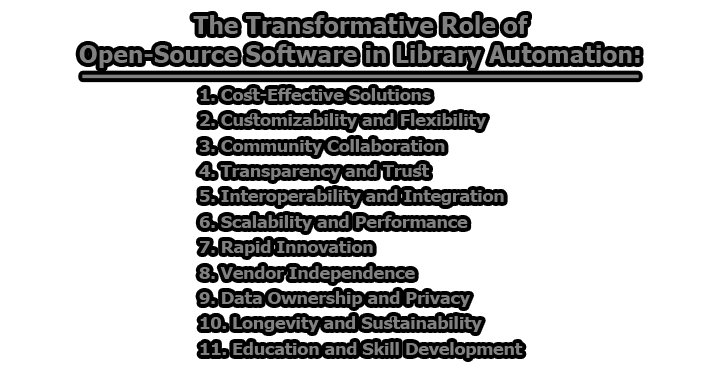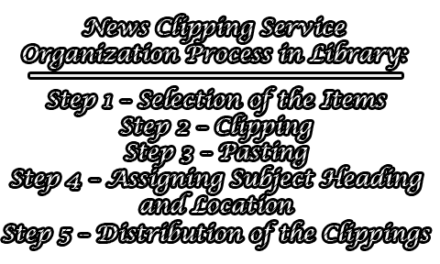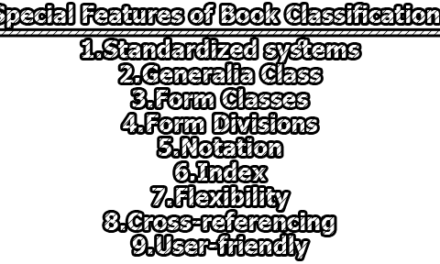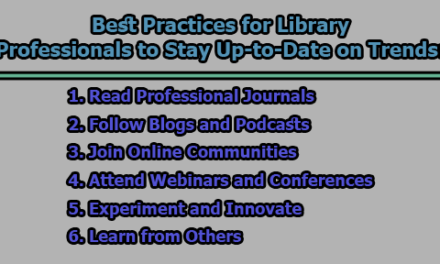The Transformative Role of Open-Source Software in Library Automation:
Libraries are dynamic institutions that have constantly evolved to meet the changing needs of society. In the modern age, technology has played a pivotal role in transforming library operations. Open-source software has emerged as a critical force driving this transformation. Open-source software, defined by licenses that grant users the rights to view, use, modify, and distribute its source code, has become a cornerstone of library automation. This article explores the transformative role of open-source software in library automation, shedding light on various pivotal aspects that have reshaped the library landscape.
1. Cost-Effective Solutions: One of the most compelling advantages of open-source software in library automation is its cost-effectiveness. Traditional library systems often come with steep licensing fees, which can strain the budgets of many libraries, especially smaller ones. In contrast, open-source solutions are typically free to use, which alleviates the financial burden on libraries’ budgets.
Case Study-Koha: Koha, an open-source Integrated Library System (ILS), serves as a prime example of a cost-effective library automation solution. Developed by a community of librarians and software developers, Koha provides libraries with all the essential tools for cataloging, circulation, and patron management without the need for expensive software licenses. This cost savings can be redirected towards enhancing library services and resources.
2. Customizability and Flexibility: Open-source software offers libraries a high degree of customizability and flexibility, allowing them to tailor their automation systems to meet their unique needs and requirements. Unlike proprietary systems that may lock libraries into rigid workflows, open-source solutions can be adapted to suit the specific workflows and processes of individual libraries.
Case Study-Evergreen: Evergreen, another open-source ILS designed for consortia and large library networks, exemplifies the customizability and flexibility of open-source library automation software. Libraries using Evergreen can modify the system to accommodate their cataloging rules, circulation policies, and other local requirements, ensuring that the software aligns seamlessly with their operational needs.
3. Community Collaboration: Open-source software thrives on community collaboration, bringing together librarians, developers, and other stakeholders to collectively improve and innovate library automation systems. This collaborative approach fosters the exchange of ideas, best practices, and the development of new features that benefit the entire library community.
Case Study-The Open Source Library Community: The open-source library community is a prime example of the power of collaboration. Communities surrounding projects like Koha, Evergreen, and Invenio work together to identify and address issues, develop new features, and share knowledge. This collaborative spirit results in software that continually evolves to meet the changing needs of libraries.
4. Transparency and Trust: Open-source software is built on principles of transparency and trust. The availability of the source code for inspection by anyone ensures that libraries have full visibility into how their automation systems work. This transparency builds trust in the software, as libraries can verify that it meets their security and privacy requirements.
Case Study-Open Source Security: Security is a top concern for libraries, particularly when handling sensitive patron data. The transparency of open-source software allows libraries to conduct security audits and assess potential vulnerabilities. When vulnerabilities are discovered, the community can quickly respond by patching and updating the software, enhancing the overall security of library systems.
5. Interoperability and Integration: In an increasingly interconnected world, libraries must integrate their systems with various external services and resources. Open-source software is well-suited for interoperability, as it often supports open standards and APIs that facilitate seamless integration with other tools and platforms.
Case Study-Open Source Middleware: Middleware solutions like OpenAthens and FOLIO, both open source, enable libraries to integrate their authentication and resource management systems with databases, e-books, and other online resources. This interoperability streamlines access for patrons and improves the overall user experience.
6. Scalability and Performance: Open-source software can be highly scalable, allowing libraries to accommodate growing collections and user bases without incurring exorbitant costs. As library needs evolve, open-source solutions can be optimized for performance to ensure efficient access and retrieval of information for patrons.
Case Study-Scalability of VuFind: VuFind, an open-source discovery system, exemplifies scalability. Libraries can configure VuFind to manage and search vast collections, making it an ideal choice for academic and research institutions with extensive resources.
7. Rapid Innovation: The open-source development model encourages rapid innovation and adaptability. Libraries can take advantage of the continuous improvement cycle of open-source software, benefiting from new features and enhancements as they become available.
Case Study-Continuous Innovation in ArchivesSpace: ArchivesSpace, an open-source archives information management system, is continually evolving to address the changing needs of archivists and researchers. Libraries using ArchivesSpace can stay at the forefront of archival practices.
8. Vendor Independence: Open-source software liberates libraries from vendor lock-in, a common issue with proprietary systems. When libraries use open-source solutions, they are not tied to a single vendor for support, maintenance, or updates. This independence gives libraries greater control over their automation systems and reduces reliance on external vendors.
Case Study-Transitioning to Vendor Independence: Libraries that transition from proprietary systems to open-source alternatives often experience increased autonomy. For example, a library that previously depended on a vendor for software updates and customizations can now rely on the open-source community or local IT expertise to meet its needs, reducing long-term costs.
9. Data Ownership and Privacy: With open-source software, libraries retain full control over their data, reducing concerns about data ownership and privacy. This control is crucial for libraries entrusted with sensitive patron information and research data.
Case Study-Data Privacy in Islandora: Islandora, an open-source digital asset management system, empowers libraries to manage digital collections while maintaining strict control over data privacy. Libraries can adhere to privacy regulations and institutional policies with confidence.
10. Longevity and Sustainability: The longevity and sustainability of library automation systems are crucial considerations. Open-source software tends to have a longer lifespan compared to proprietary software, as it can be maintained and improved by a diverse community of contributors over an extended period.
Case Study-Longevity of Open Source Projects: Projects like Open Source ILSs (Integrated Library Systems) have been actively developed and maintained for many years, demonstrating their sustainability. This sustained effort ensures that libraries can continue to rely on their automation systems without facing the risk of sudden discontinuation or obsolescence.
11. Education and Skill Development: Implementing open-source solutions encourages library staff to develop valuable technical skills. Staff can gain expertise in system administration, coding, and other areas, which can lead to professional growth and career advancement.
Case Study-Staff Development at Bibliotech: Bibliotech, a library service provider in the UK, has embraced open source and invested in staff training. This approach has not only enhanced their library automation capabilities but also empowered their staff to develop technical competencies.
In conclusion, the transformative role of open-source software in library automation is evident in its cost-effective solutions, customizability and flexibility, community collaboration, transparency and trust, interoperability and integration, vendor independence, longevity, and sustainability. These aspects collectively contribute to the evolution of libraries into modern information hubs that efficiently serve their patrons’ needs.
As libraries continue to adapt to evolving technological landscapes and changing user expectations, open-source software remains a powerful tool that empowers libraries to innovate, collaborate, and provide high-quality services in an ever-digital world. The future of library automation is closely intertwined with the open-source movement, ensuring that libraries can thrive in the 21st century and beyond.

Assistant Teacher at Zinzira Pir Mohammad Pilot School and College










